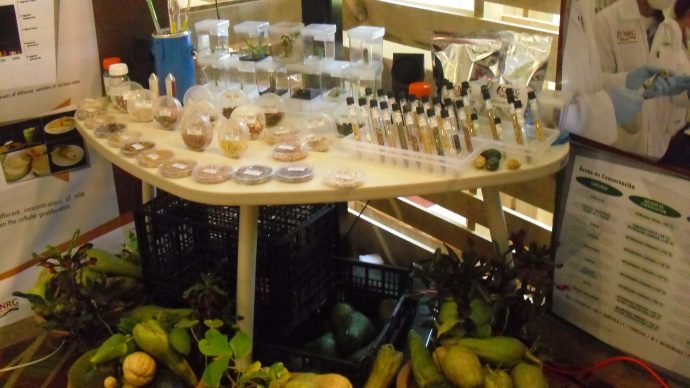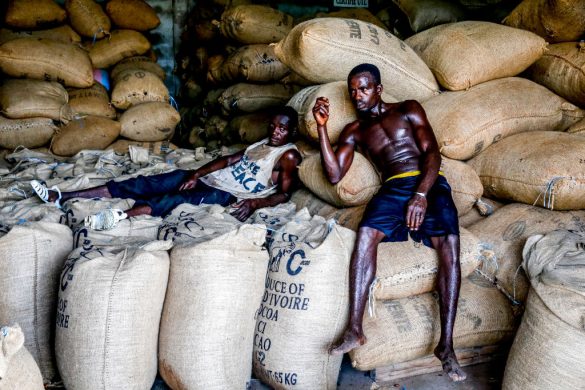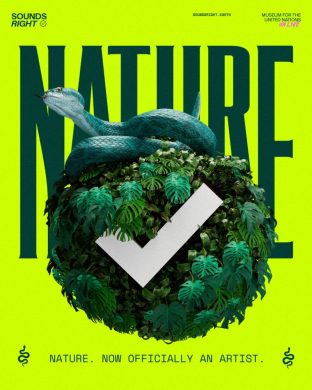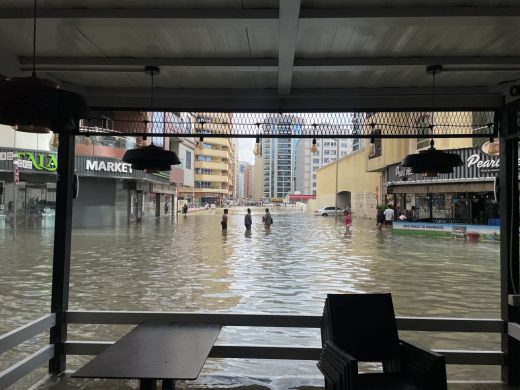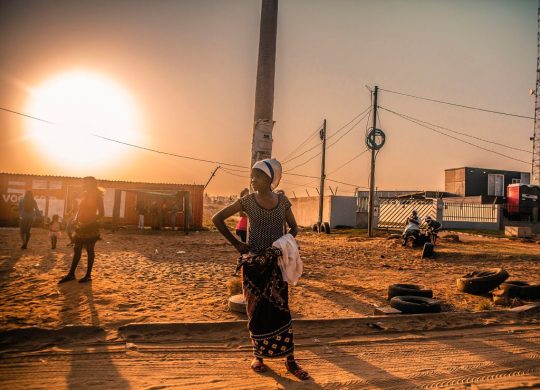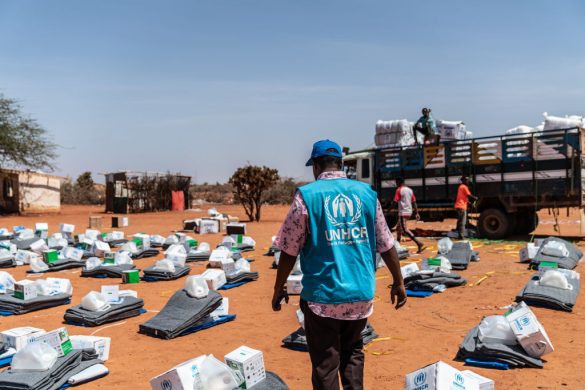Three reptile species found only on an Australian island – the Christmas Island Whiptail-skink, the Blue-tailed Skink (Cryptoblepharus egeriae) and the Lister’s Gecko – have gone extinct, according to the update.
But in New Zealand, conservation efforts have improved the situation for two species of Kiwi.
“Healthy, species-rich ecosystems are fundamental to our ability to feed the world’s growing population and achieve the UN Sustainable Development Goal 2 – to end hunger by 2030,” says IUCN Director General Inger Andersen.
“Wild crop species, for example, maintain genetic diversity of agricultural crops that can adapt to a changing climate and ensure food and nutritional security. Today’s IUCN Red List update raises the alarm about their decline and stresses the urgency to address it – for the sake of our own future.”
Unsustainable agriculture and urbanisation threaten wild crop species
Twenty-six species of wild wheat, 25 species of wild rice and 44 species of wild yam have been assessed for The IUCN Red List, many for the first time, thanks to funding from the IUCN–Toyota strategic partnership to expand knowledge of threats to global biodiversity.
In total, three species of wild rice, two species of wild wheat and 17 wild yam species are threatened. Deforestation and urban expansion alongside pressures from intensive agriculture, particularly over-grazing and extensive use of herbicides, are the primary threats to these species.
Cross-breeding modern crop cultivars with crop wild relatives adds necessary genetic diversity, improving resistance to drought, disease and pests – all of which are likely to become increasing problems in a changing climate.
A recent study has found that almost three-quarters (72%) of crop wild relatives are not adequately preserved in gene banks and conservation in situ in the wild remains challenging.
Crop wild relatives are highly economically valuable, contributing US$115 billion annually to the global economy, and there is potential to significantly expand this in future.
“The genetic diversity provided by crop wild relatives will allow us to develop more resilient crops in the era of climate change, helping ensure food security. We ignore the fate of these species at our own peril,” explains Nigel Maxted, Co-chair of the IUCN SSC Crop Wild Relative Specialist Group.
“Assessing crop wild relatives for The IUCN Red List gives us in-depth information on the threats these species face. Thanks to the new assessments, we can now act systematically to conserve crop wild relatives by reducing overly intensive agricultural practices such as overgrazing and indiscriminate herbicide use.”
Climate change threat to Australian Ringtail Possum
Australia’s increasingly dry and hot climate has led to a dramatic decline of the Western Ringtail Possum (Pseudocheirus occidentalis), which has moved from Vulnerable to Critically Endangered due to a fall in species numbers by over 80% in the past ten years.
The Possum was once widespread in peppermint (Agonis flexuosa) and tuart (Eucalyptus gomphocephala) forests in Western Australia, but is now limited to fragmented coastal habitats.
Attempts to re-establish the species in Lane-Poole Conservation Park, about 100 km south of Perth, have failed largely due to poor food quality resulting from a drying climate. Western Ringtail Possums require relatively high quality food – particularly peppermint leaves – due to their specialised digestive systems.
The Western Ringtail Possum is susceptible to heat stress and can overheat at temperatures above 35ºC, increasingly common in this part of Australia. Possum numbers have also been impacted by urban development and predation from the Red Fox (Vulpes vulpes) and feral cats (Felis catus), logging, fire outbreaks and inappropriate fire management regimes.
Asian dolphin and porpoise species threatened by unsustainable fishing
The Irrawaddy Dolphin (Orcaella brevirostris) and Finless Porpoise (Neophocaena asiaeorientalis) have both declined, moving from the Vulnerable to the Endangered category.
Numbers more than halved over the past 60 years for the Irrawaddy Dolphin, and over the past 45 years for the Finless Porpoise.
Both species live only in shallow waters near shore, and both have populations confined to freshwater systems, which makes them extremely vulnerable to human activities.
They are prone to accidental entanglement in non-selective fishing nets – the primary cause of their decline. Further causes of decline include the overfishing of prey and habitat destruction.
“The Irrawaddy Dolphin is revered by many communities and dolphin tourism is an important feature of local economies in parts of India and Cambodia,” says Randall Reeves, Chair of the IUCN SSC Cetacean Specialist Group.
“While the protected status of both species means that deliberate hunting or capture is rare or non-existent, protection from entanglement and other threats is either lacking entirely or largely ineffective. Without practical solutions to this problem, the declines of dolphins and porpoises are bound to continue for the foreseeable future.”
In the Mekong River, the majority of Irrawaddy Dolphin deaths in recent years have been caused by entanglement in gillnets ̶ ‘curtains’ of fishing net that hang in the water. Gillnets are the largest global threat to marine mammals.
Efforts to ban or at least manage their use have, in many areas, been ineffective, resulting in declines of many species of whales, dolphins and porpoises, including the Critically Endangered Vaquita porpoise (Phocoena sinus) and the Baiji dolphin (Lipotes vexillifer), which is listed as Critically Endangered but likely already Extinct.
Invasive species and habitat loss pushing Japanese reptiles towards extinction
One third of the 46 endemic Japanese snakes and lizards newly assessed for The IUCN Red List are listed as threatened. Populations of these reptiles are small and fragmented, which increases their vulnerability to changes in habitat.
Across Japan, species declines have been accelerated by habitat loss resulting from unsustainable agriculture and urban development.
Collection for the pet trade and threats from invasive species, such as the Indian Peacock (Pavo cristatus) and the introduction of the Japanese Weasel (Mustela itatsi) to some of the smaller Japanese islands, are also to blame.
Now listed as Critically Endangered, the Kikuzato’s Stream Snake (Opisthotropis kikuzatoi), endemic to Kumejima Island and the rarest of all snakes in Japan, was relatively common until the mid-1990s.
This species declined dramatically over the past 15 years due to predation from the invasive Bullfrog (Lithobates catesbeianus), Japanese Weasel and Indian Peacock, with the snake’s small and fragmented range accelerating the decline. Pollution and incidental capture as bycatch have also impacted species numbers.
Similar threats also affect the Banded Ground Gecko (Goniurosaurus splendens), endemic to Tokunoshima Island and Miyako Grass Lizard (Takydromus toyamai), endemic to the Miyako Islands, both of which enter The IUCN Red List as Endangered.
Funding from the IUCN–Toyota partnership has enabled the assessments of these Japanese reptile species.
Mysterious extinctions on Australia’s Christmas Island
Three reptile species endemic to an Australian island have gone extinct in the wild – Lister’s Gecko (Lepidodactylus listeri) – and two scincid lizards, the Blue-tailed Skink (Cryptoblepharus egeriae) and the Christmas Island Forest-skink (Emoia nativitatis).
Overall, populations of Christmas Island reptiles have declined rapidly since the 1970s. While the reason for their decline remains unclear, predation by the invasive Wolf Snake (Lycodon capucinus), introduced to the island in the mid-1980s may be to blame.
The introduction of a novel disease and changes in island ecology following the introduction of the Yellow Crazy Ant (Anoplolepis gracilipes) may have placed further pressure on these reptile species.
Efforts to establish a captive breeding programme for the Forest Skink failed in 2013 and the species has now been moved from Critically Endangered to Extinct.
Although captive breeding populations are now well-established for the Lister’s Gecko and the Blue-tailed Skink, both species have been declared Extinct in the Wild.
Island populations of endemic species are particularly susceptible to decline due to their small populations, limited genetic diversity, lack of immunity to novel diseases and naivety towards introduced predators, according to the Red List.
Kiwi species recover as conservation efforts pay off
Intensive predator control on small New Zealand islands has led to the re-categorisation of the Okarito Kiwi (Apteryx rowi) and the Northern Brown Kiwi (Apteryx mantelli) from Endangered to Vulnerable, according to today’s Red List update.
Both species of Kiwi have been facing threats including habitat loss and predation by introduced mammals, such as stoats (Mustela erminea) and feral cats. The Northern Brown Kiwi is also threatened by predation from ferrets (Mustela furo) and dogs.
Government and community conservation efforts have focused on predator control, and removing and incubating eggs for release into the wild.
The Okarito Kiwi has increased from 160 individuals in 1995 to between 400 and 450 adults today. Overall, Northern Brown Kiwi populations are estimated to be growing by over 2% per annum, although unmanaged populations continue to decline.
The re-categorisation of the Kiwis forms part of a wider assessment of New Zealand birds, which highlights that many endemic species are in decline, often as a result of invasive species.

